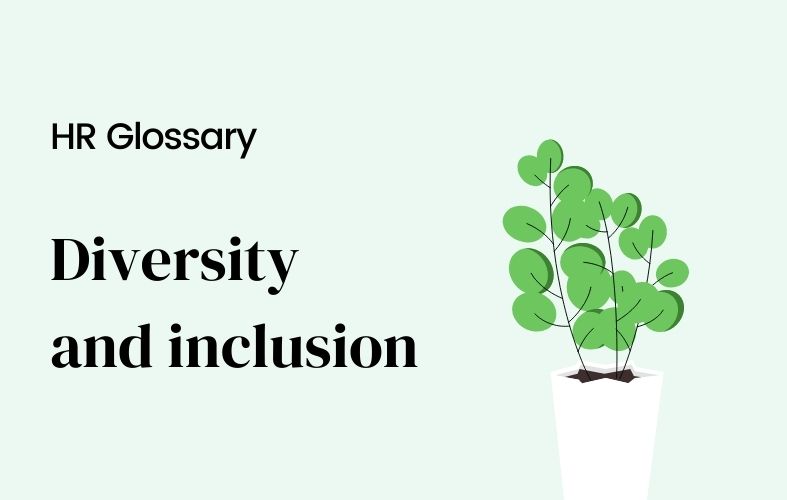Diversity and inclusion

[Sommaire]
What are diversity and inclusion?
Diversity and inclusion (often shortened to D&I) are two related topics. They focus on ensuring the contributions of as broad a group of people as possible in an organization.
Diversity is about all the ways in which people differ. These include age, ethnicity, gender, physical abilities, race, sexual orientation, and more.
Inclusion is about ensuring everyone feels like they belong and are valued for who they are.
Diversity and inclusion are often discussed together because they go hand-in-hand.
Why are diversity and inclusion important?
Diversity and inclusion are important from a moral perspective and a business success perspective.
From a moral perspective, diversity and inclusion are important because giving everyone the opportunity to thrive and achieve in an organization is the right thing to do.
Diversity and inclusion are important from a business success perspective because many studies have proved that diverse and inclusive companies are more successful. They take fewer risks, are more financially successful, and are more creative.
What is the difference between diversity and inclusion?
Although diversity and inclusion are often grouped as a single term, they are two different concepts. An easy way to understand the difference is in the explanation offered by Verna Myers,
“Diversity is being invited to the party. Inclusion is being asked to dance.”
In other words, diversity is about recognizing differences, the value of different perspectives, and having a representative spread of individuals in your organization. Inclusion efforts ensure everyone has an equal opportunity and feels comfortable and welcome at your organization.
What are diversity and inclusion in the workplace?
Specifically, in the workplace, your approach to diversity and inclusion is an important part of your company culture. It is about valuing everyone in your business as an individual and allowing everyone to participate fully.
Good diversity and inclusion practices in your workplace go above and beyond legislative requirements and aim to bring value to an organization as well as enhance employee resource groups' experience and well-being.
What are some common diversity and inclusion challenges?
There are many diversity and inclusion challenges that organizations face. One common challenge is self-segregation, which occurs when people with similar backgrounds or perspectives tend to stick together.
This can lead to echo chambers where people only hear perspectives that align with their own, which can make it difficult to understand and empathize with others.
Other diversity and inclusion challenges include unconscious bias, which is when people make decisions based on preconceptions that they may not even be aware of, and microaggressions, which are small slights or comments that can have a big impact on someone’s feeling of inclusion.
How can you promote diversity and inclusion in the workplace?
Creating a diverse workforce in an inclusive environment is not a one-off initiative. It requires continuous improvement and must have the support of senior management and leadership. Developing and implementing a strong diversity strategy should cover factors including:
-
Behavior
Train employees to understand the inclusive culture and learn how to embed it in their roles and team working. Make clear what behavior is and is not acceptable and introduce tools to deal with bullying, harassment, and intimidation.
-
Communications
Ensure everyone in your organization knows about and buys into the importance of inclusion initiatives. Use diverse role models in your marketing and communications campaigns to show what inclusive gender-diverse companies look like.
-
Policies
Review all policies with an eye to ensure they are not discriminatory and that they foster a culture of inclusion throughout the organization.
-
Learning and development
Train line managers to help them understand D&I, drive their support, and build diversity and inclusion topics into staff training, onboarding, and team-building sessions.
-
Measurement
Regularly assess your workforce’s diversity and inclusion data. This should include monitoring factors such as absenteeism and turnover to assess the effectiveness of the inclusion and diversity initiative.
How do effective diversity and inclusion programs typically impact a company’s reputation?
If well implemented, a diversity and inclusion program can positively impact a firm’s reputation in a number of ways:
Improved culture and employer brand
Employee engagement is higher in inclusive organizations. This can build your company culture and make your organization seem like a more attractive place to work. This can make it easier to attract high-quality talent from a range of diverse backgrounds.
Reduced legal risk
A strong diversity and inclusion program can help to protect your organization from discrimination lawsuits.
Increased creativity and innovative potential
More diverse talent is likely to be more creative and innovative. This is because people from different backgrounds bring different perspectives and experiences to the table.
Improved financial performance
As mentioned earlier, a more diverse and inclusive workplace can lead to improved financial performance. This is because organizations with a diverse workforce are better able to tap into new markets and understand the needs of a wider range of customers.
Improve creativity and innovation
By having a more inclusive and diverse workplace, your output is stronger. And with more creative, helpful products and services, your firm’s reputation will improve.
Increased relevance
By hiring a workforce representative of the population you serve, your reputation will improve as clients and customers recognize you as a relevant brand, suitable for “people like us.”
Diversity in the workplace statistics
- It is estimated that by 2030, 50% of the U.S. workforce will be composed of people from minority groups.
- A study by McKinsey & Company found that companies in the top quartile for racial and ethnic diversity are 35% more likely to have financial returns above their respective national industry medians.
- The same study found that companies in the top quartile for gender diversity are 15% more likely to have financial returns above their respective national industry medians.
- A study by Deloitte found that organizations with inclusive cultures are 2.3 times more likely to meet or exceed their financial targets.
- A study by BCG found that organizations with Diversity & Inclusion (D&I) programs are twice as likely to be innovation leaders in their industries.
- A study by MIT found that the most diverse companies are also the most successful, with revenue 37% higher than less diverse companies.
- A study by DiversityInc found that the top 25 firms for Diversity & Inclusion outperformed the S&P 500 financially by 33%.
- A study by Accenture found that organizations with a strong Diversity & Inclusion program are 60% more likely to be successful with their mergers and acquisitions.
- A study by The Boston Consulting Group found that organizations with diverse management teams were 19% more likely to have above-average profitability.


